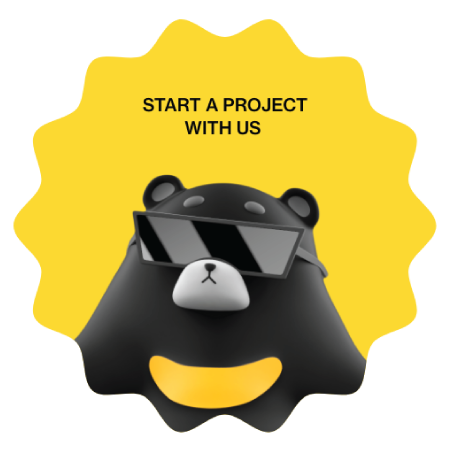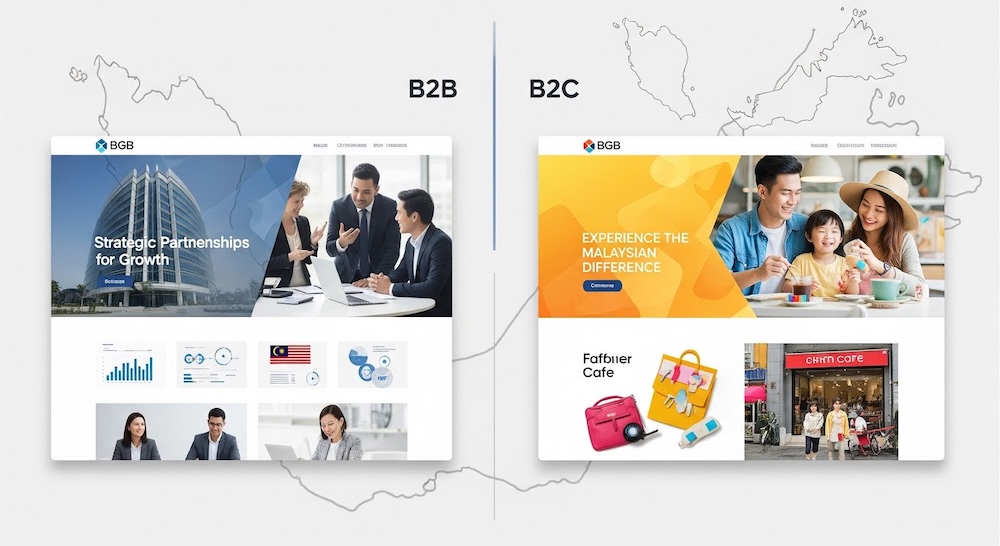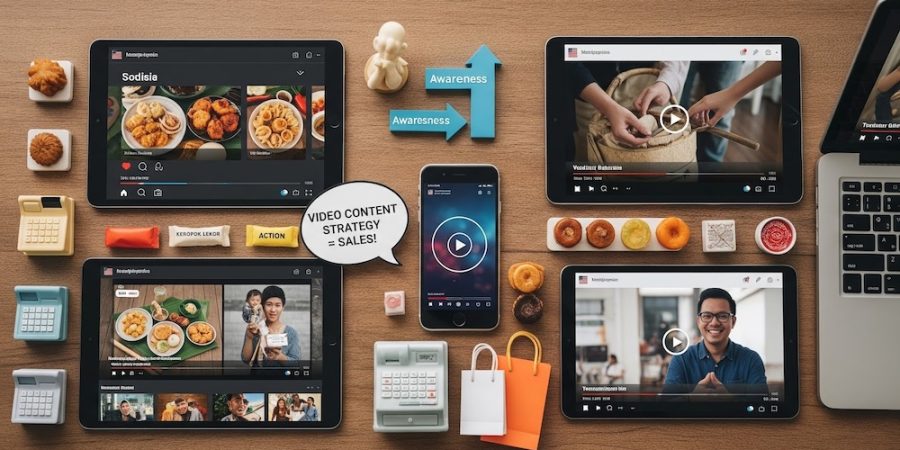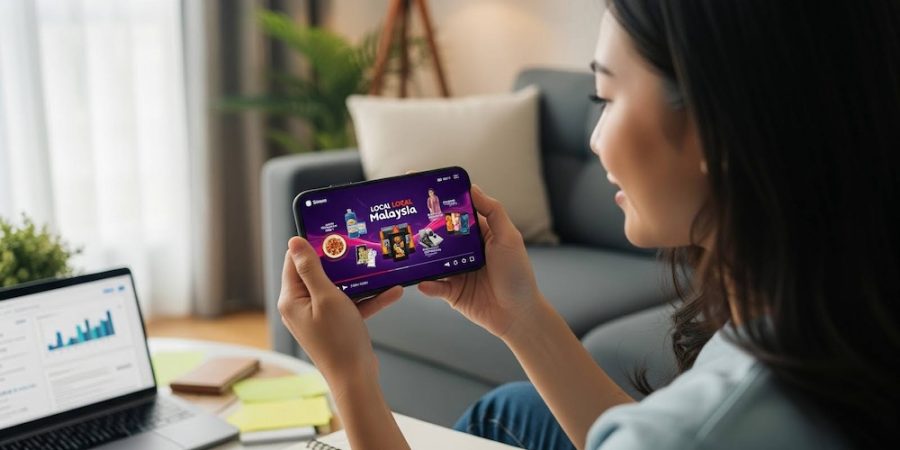Key Takeaways
- B2B and B2C websites serve different audiences and require tailored branding strategies aligned with decision-making behaviours.
- B2B websites focus on building trust, showcasing technical expertise, and supporting long sales cycles; B2C sites prioritise emotional connection and fast conversions.
- Investment costs and ROI timelines differ: B2B projects are larger and more complex, while B2C websites focus on visual appeal and user experience.
- Common mistakes include using generic messaging, neglecting mobile UX, and treating branding as a one-time task.
- Malaysian examples like EcoWorld (B2B) and Mamee (B2C) show how local branding success combines audience insight with world-class design.
Introduction
Did you know that 94% of first impressions are design-related?
Yet many Malaysian businesses lose millions in potential revenue by using the wrong branding approach for their target audience.
In Malaysia's competitive digital landscape, understanding the fundamental differences between B2B vs. B2C website branding isn't just helpful — it's essential for business success.
Whilst both approaches aim to connect with audiences and drive conversions, the strategies, design principles, and customer journeys they employ are markedly different. By the end of this guide, you'll understand exactly which approach suits your business, how much to invest, and what mistakes to avoid.
What is B2B Website Branding Design?
B2B branding and website design focus on creating professional, relationship-driven experiences that support complex decision-making processes. Unlike consumer-focused sites, B2B website design must appeal to multiple stakeholders within an organisation, each with different priorities and concerns.
Key Features of Effective B2B Website Design
The hallmarks of successful B2B website branding include:
- Comprehensive product information with technical specifications
- Detailed case studies showing measurable business outcomes
- Clear pricing structures or quote request systems
- Trust signals through industry certifications and testimonials
- Content depth that supports 3-12 month sales cycles
B2B website design requires a careful balance between professional credibility and engaging user experience. The design must support longer sales cycles whilst maintaining visitor interest through multiple touchpoints — from initial research to final purchase decision.
What is B2C Website Branding Design?
Website design for B2C focuses on creating emotional connections with individual consumers, prioritising immediate engagement and streamlined purchasing experiences. B2C website design emphasises visual appeal, brand personality, and intuitive navigation that guides users towards quick purchasing decisions.
Essential B2C Website Elements
Successful B2C website design typically features:
- Lifestyle storytelling showing products in real-world contexts
- Mobile-first optimisation for smartphone shoppers
- Frictionless checkout with multiple payment options
- Social proof through customer reviews and ratings
- Visual appeal with vibrant imagery and engaging videos
B2C websites must excel at converting visitors within minutes or seconds, making emotional connection and user experience paramount to success.
Learn more about website branding at: What Is Website Branding? A Guide for Malaysian Business Owners
B2B vs. B2C Website Branding Differences
The distinctions between B2B and B2C website branding extend far beyond surface-level design choices. Here's what Malaysian businesses need to understand:
Target Audience Complexity
B2B companies target a smaller, more specific audience requiring deep niche understanding. B2C companies cast wider nets, building brand awareness among diverse consumer segments.
Decision-Making Processes
- B2B websites support multiple stakeholders making collective decisions over months
- B2C websites target individual consumers, making faster, emotion-driven choices
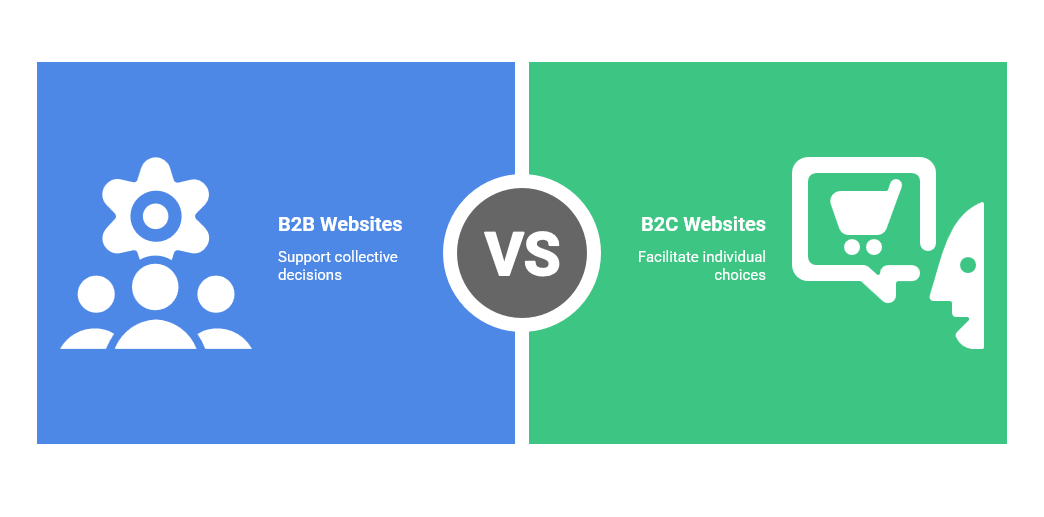
Content Strategy Requirements
B2B branding must convey expertise through educational content, whilst B2C branding must convey benefits through lifestyle-focused messaging.
| Aspect | B2B Website Branding | B2C Website Branding |
| Primary Goal | Lead generation and relationship building | Direct sales and brand awareness |
| Decision Makers | Multiple stakeholders | Individual consumers |
| Sales Cycle | Long (3-12 months) | Short (minutes to days) |
| Content Focus | Educational, technical | Lifestyle, emotional |
| Pricing Display | Complex, often requires quotes | Simple, upfront pricing |
| Mobile Priority | Desktop-first, mobile-optimised | Mobile-first design |
B2B vs. B2C Website Branding Costs in Malaysia
Understanding investment requirements helps Malaysian businesses make informed decisions about their digital presence.
B2B Website Branding Investment
B2B website design typically requires RM25,000 to RM80,000 for comprehensive projects, reflecting complex functionality needs:
- Customer portals and CRM integration
- Detailed product catalogues
- Sophisticated lead capture mechanisms
- Extensive content development
B2C Website Branding Investment
B2C website projects range from RM8,000 to RM40,000, focusing on:
- Visual appeal and user experience
- E-commerce functionality
- Payment gateway integration
- Social media integration
Typical ROI Timeline: Malaysian businesses see returns within 6-12 months when branding aligns with audience needs and business goals.
Learn more about ROI at: The ROI of Strategic Web Design: A Behind-the-Scenes Look at Mamee’s Site Revamp.
Why do Both B2B and B2C Businesses Need Website Branding?
In Malaysia's digital-first economy, website branding addresses unique challenges for both business models:
Building Trust and Credibility
Professional branding signals reliability within milliseconds — crucial for Malaysian consumers and businesses who are increasingly discerning about their choices.
Competitive Differentiation
Malaysia's competitive landscape demands clear value communication. This is particularly vital for B2C ecommerce website businesses in crowded marketplaces.
Supporting Business Growth
Strong branding provides consistent messaging across SEO, paid advertising, and social media channels, improving conversion rates across all touchpoints.
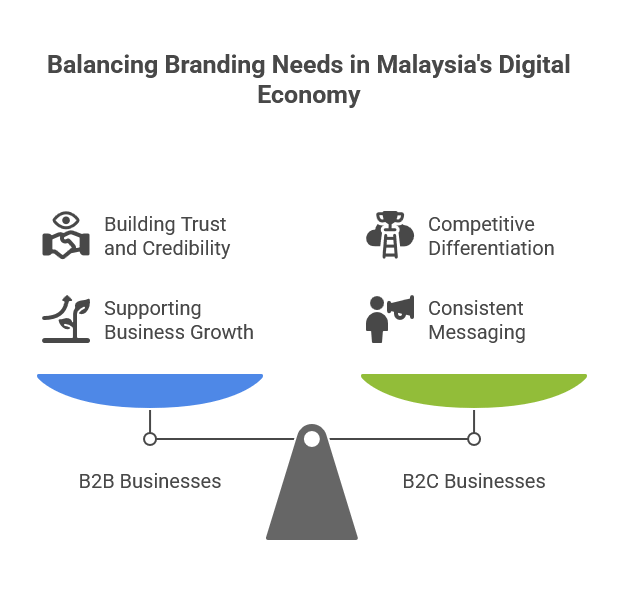
Best Practices for B2B and B2C Website Branding
Successful website branding requires understanding your audience's specific needs and behaviours. Both B2B and B2C businesses can benefit from following proven best practices whilst adapting them to their unique contexts.
B2B Website Branding Best Practices
A successful B2B website strategy begins with understanding decision-makers' needs:
Content and Information Architecture
- Show exact pricing whenever possible—B2B customers are price-conscious
- Implement robust search and filtering functionality
- Include detailed integration and compatibility information
- Publish regular thought leadership content
Trust Building Elements
- Display industry certifications prominently
- Feature detailed case studies with measurable outcomes
- Provide clear contact information for sales teams
- Include technical specifications and documentation
B2C Website Optimisation Strategies
B2C websites should prioritise emotional connection:
User Experience Focus
- Ensure mobile-first, responsive design
- Streamline checkout with multiple payment options
- Integrate customer reviews and user-generated content
- Use high-quality imagery showing lifestyle benefits
Conversion Optimisation
- Implement fast loading times (under 3 seconds)
- Create clear value propositions
- Add social sharing capabilities
- Use scarcity and urgency tactics appropriately
Action Item: Audit your current site — does it follow the practices for your business model?
Common B2B and B2C Website Branding Mistakes in Malaysia
Understanding common pitfalls helps Malaysian businesses avoid costly mistakes and create more effective website branding strategies.
Critical Errors to Avoid:
- Generic Messaging: Failing to differentiate from competitors
- Mobile Neglect: Poor mobile experience despite Malaysia's high mobile usage
- Cultural Disconnect: Ignoring local preferences and business practices
- B2C Overcomplication: Overwhelming consumers with too much information
- B2B Content Gaps: Insufficient technical details or missing case studies
- One-Time Thinking: Treating branding as a project vs. an ongoing process
- Poor System Integration: Disconnected websites and business tools
B2B and B2C Website Branding Examples and Case Studies in Malaysia
-
Outstanding B2B Website Example: EcoWorld
EcoWorld exemplifies an effective B2B website example design for diversified property development. Key success factors:
- Dynamic content organisation using tabs and sections
- Clear visual hierarchy with bold titles and striking imagery
- Comprehensive navigation managing complex multi-division content
- Professional credibility, maintaining trust across business units
-
Exceptional B2C Website Example: Mamee
Mamee showcases outstanding B2C website examples with personality-driven design:
- Emotional storytelling that creates "carnival ride" experiences
- Vibrant brand personality using bold colours and engaging characters
- Product showcase excellence, highlighting diverse category offerings
- Consumer connection through relatable brand narrative
These examples demonstrate that successful Malaysian website branding requires understanding local market dynamics whilst implementing international best practices.
FAQ
What's the difference between B2B and B2C website SEO in Malaysia?
B2B SEO targets industry-specific, low-volume keywords with high commercial intent, whilst B2C SEO focuses on broader, high-volume product and lifestyle queries.
How long does B2B website branding take compared to B2C in Malaysia?
B2B projects typically require 3-6 months due to complex stakeholder processes, whilst B2C projects take 2-4 months, focusing on visual design and user experience.
Can one website serve both B2B and B2C audiences effectively?
Yes, through strategic B2B2C design using distinct sections whilst maintaining consistent branding, increasingly popular among Malaysian manufacturers.
Should Malaysian startups start with B2B or B2C website branding first?
Consider your target market size, competition level, and resources. B2C offers faster feedback cycles, whilst B2B provides more stable, higher-value relationships.
How do mobile users behave differently on B2B vs. B2C websites in Malaysia?
Malaysian B2B users research on mobile but often complete transactions on desktop, whilst B2C users complete entire purchase journeys on mobile devices.
Conclusion: How BikeBear Excels at Both B2B and B2C Website Branding
The distinction between B2B vs. B2C website branding isn't just about different design approaches — it's about understanding fundamentally different audience needs, behaviours, and decision-making processes.
As a leading B2B website design agency and B2C website design agency, BikeBear understands that successful website branding requires strategic thinking, audience insight, and technical expertise aligned with business objectives.
Malaysian companies recognise that website branding isn't a luxury — it's a necessity. Businesses investing in professional, strategically designed websites see measurable returns through increased leads, higher conversion rates, and stronger brand recognition.
Ready to transform your website into a powerful branding asset?
Discover how BikeBear can help your business succeed:
- Professional Branding Services - Strategic brand development for Malaysian businesses
- Expert Web Design Solutions - Custom websites that convert visitors into customers
Contact us today for a free consultation and discover which approach — B2B or B2C — will drive the best results for your Malaysian business.

